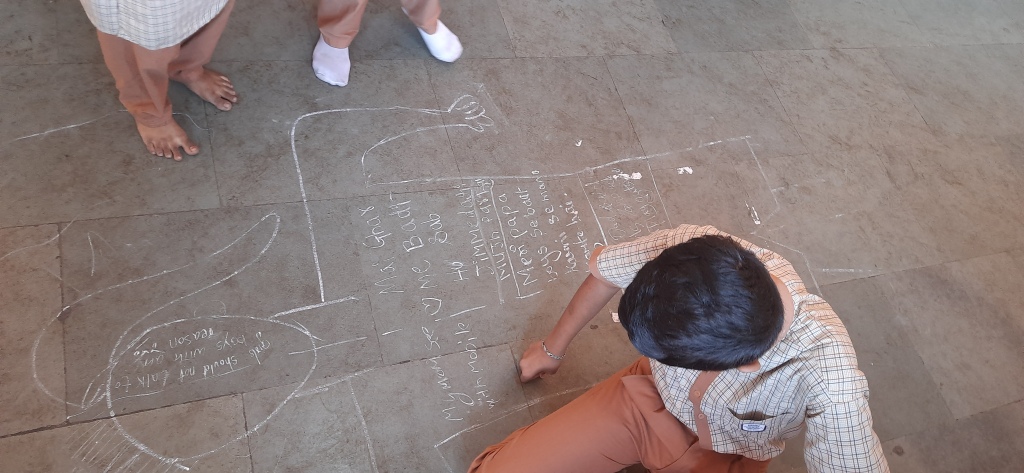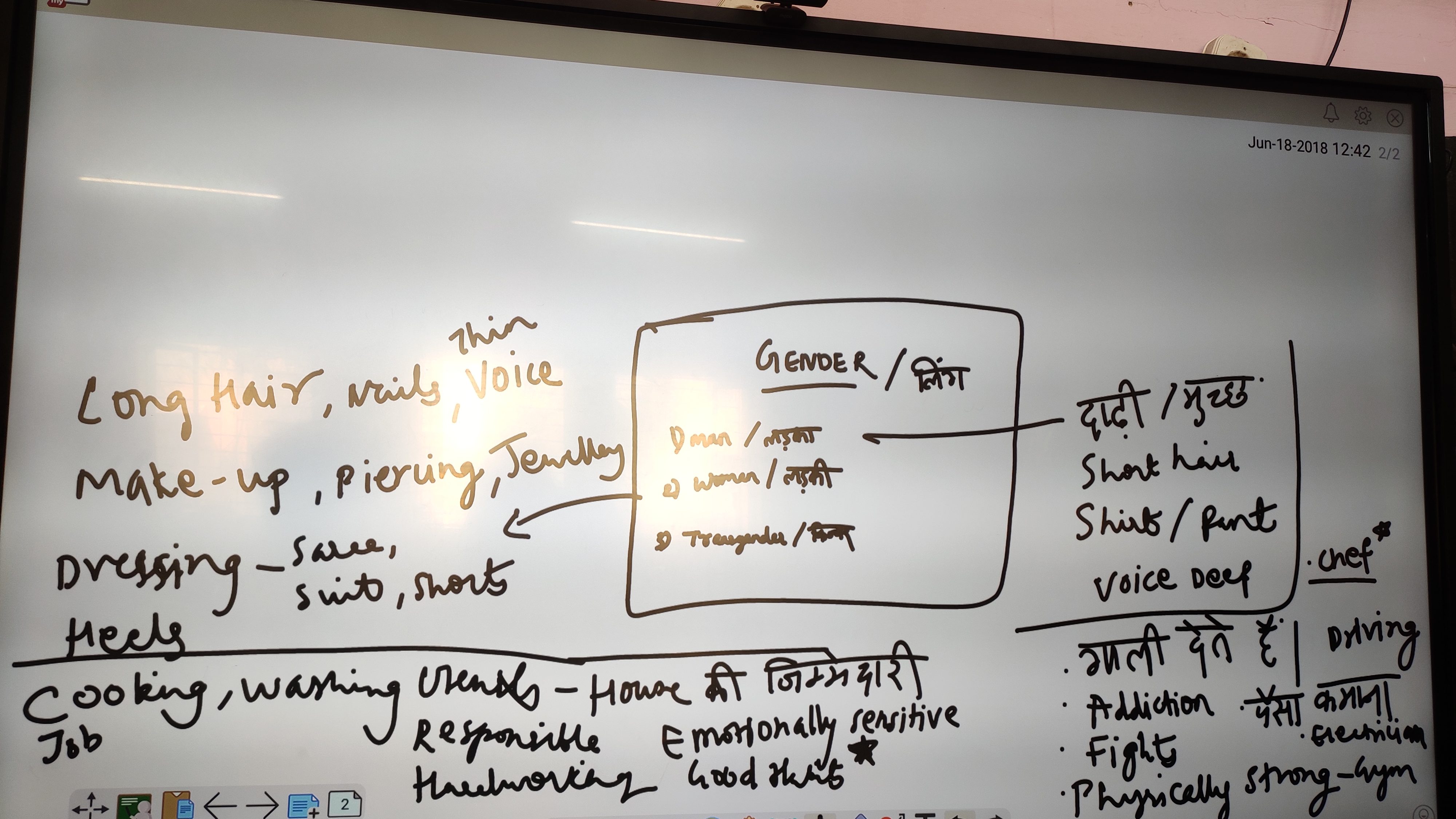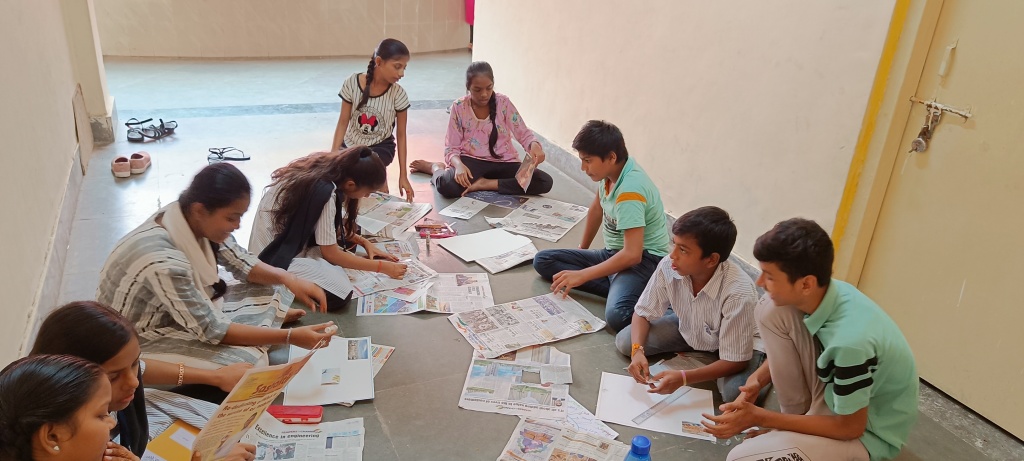A reflection piece by Meghna and Pooja
इस आर्टिकल को हिंदी में पढ़ने के लिए यहाँ क्लिक करें। हा आर्टिकल मराठी मध्ये वाचण्यासाठी, येथे क्लिक करा।

Do you think that your learning experience is affected by the gender identity of your teacher or facilitator?
When facilitating Social-Emotional Learning (SEL), we work with the students and the school ecosystem, including teachers, principals, parents and other caregivers. On this journey, we, the facilitators, also deepen our understanding of SEL. Many factors influence this learning journey, and one of them is identity, both for the students and the facilitators.
We believe identity plays a central role in students’ learning journey and educators’ facilitation journey. We work in an ecosystem where multiple identities interact with and affect each other in several ways. The various identities that may come about (especially in an Indian classroom setting) are caste, class, gender, ability, race, and sexuality, amongst others. While acknowledging the intersecting identities, this article will specifically delve into gender as an identity. It’s crucial to note that gender is a complex, multifaceted concept not limited to a binary understanding. However, for this article, we have primarily focused on the gendered experiences of ourselves and individuals we are familiar with, i.e. the facilitators who work with us at Apni Shala, who predominantly identify as cisgender men and women.
While researching and reflecting on this topic, a student approached me (Pooja) and my male facilitator one day, referring to him as “teacher.” The student quickly apologised to the facilitator. When I asked why, he said he should have addressed the male facilitator as “sir.” This made me reflect on the gendered connotations of titles like “teacher” and “sir.” Curious, I asked the student why he thought these titles were gender-specific. His response was short; he simply said it’s what everyone does, then hurried away. In that moment the student’s words shed light on how societal values influence our perceptions.
The inherent gendering of the term ‘teacher,’ in contrast to the neutral connotation of ‘facilitation,’ underscores prevailing societal norms and expectations. One male facilitator shared with us that his students would not let him call himself a ‘teacher’ because ‘sir’ is more respectful, and the term ‘teacher’ addresses someone who identifies as female. As facilitators, we have embraced this linguistic shift, choosing not to insist on traditional titles like ‘teacher’ or ‘sir.’ Instead, we encourage our students to address us as “Bhaiya” and “Didi.” This intentional move seeks to mitigate power dynamics but still sustains the gender aspect of the relationship. We use the words “Bhaiya” and “DidI” to build a close relationship with students, where we can freely share our thoughts and stay connected. Some students have mentioned that when they call us Didi and Bhaiya, they feel comfortable expressing themselves.
As co-facilitators, we (Meghna and Pooja) have experienced similar things in classrooms. Students often openly share their thoughts with us, and sometimes even address us as ‘Aapi’ or ‘Maa’, implying a sort of personal connection that they share with us. They have also revealed to us that when conversing with us, they realise that there is a space where they have the freedom to pursue their interest and can openly articulate their thoughts and emotions, freeing them from any burden or judgment. For them, it is a space that gives them a feeling of security in expressing themselves.
In a poignant instance during my (Meghna’s) facilitation on “gender roles”, the impact of gender became palpable. I shared a personal reflection, navigating the complexities of societal expectations. When I addressed the seeming contradiction between my gender role and my career aspirations, female students resonated deeply. Seeing how my role as a female facilitator goes beyond the instructional was a powerful revelation. It inadvertently acts as a living example, challenging traditional norms and inspiring female students to envision futures beyond societal constraints. The gender of the facilitator, in this context, becomes a powerful catalyst for breaking gender stereotypes, creating a ripple effect that empowers students to embrace their aspirations irrespective of societal expectations.

In one of my (Pooja’s) 5th grades, my co-facilitator and I identify as cisgender women. One day, I had to lead the session alone when she was on leave. In that session, the students were chatting with each other a lot and were not able to pay attention. I decided to bring a support facilitator, who identifies as a male. Despite my efforts, the class remained noisy initially. The class gradually quieted down only when my support facilitator stepped in, addressing the students directly. Reflecting on this incident later, I found myself questioning the dynamics of the session. Surprisingly, the students listened more calmly when my support facilitator was present. This experience triggered self-doubt in me. One of my students even approached me, saying, “Didi, bring sir with you every day, so everyone will listen to you because all the students are afraid of male teachers.”
In a Grade 8 session typically co-facilitated with a male colleague, a fellow female-identifying facilitator found themselves leading the class alone, revealing challenges in working with a few male students. The facilitator presented an activity to the class. Some male students sitting at the back of the classroom engaged in unrelated activities, i.e., painting and drawing, instead of performing the required activity. Upon enquiring into these actions calmly, one student disclosed that his compliance was contingent on the presence of the male co-facilitator, revealing a broader pattern within his social circle. He confidently asserted that he would follow the instructions only if conveyed by “bhaiya,” mentioning that his friends would do the same.
Upon further discussion, it became apparent that the resistance wasn’t rooted in a preference for painting during the session but rather in the gender dynamic. The student explicitly stated’ “Didi main aapki kyu sunu? Main sirf bhaiya ka sununga kyuke vo mere friend hai, girls mere friend nahi hai (Didi why should I listen to you? I will only listen to bhaiya because he is my friend, girls are not my friend)”. Upon further questioning whether he would listen to the male facilitator if he were present right now he replied with a, “Yes”. This preference for male authority figures extended across various classes, where students displayed greater engagement and attentiveness when the male co-facilitator was leading, highlighting the intricate influence of gender dynamics in the classroom and prompting the individual to reflect on strategies for fostering a more inclusive learning environment.
Understanding and addressing these dynamics is crucial for fostering an inclusive and respectful learning environment. The facilitator (female-identifying colleague) believes open communication and collaboration can be essential in challenging and transforming these gender-related biases.

A male-identifying facilitator shared that when in a classroom, students sometimes perceive him as a strict figure, leading to them only asking him cognitively driven questions. They rarely share their emotions and feelings with him. He says they form an emotional connection with a female counterpart but not with him. He also shared that when students reached out to him, they expressed his presence is a reminder of their father. The acknowledgement of people gravitating towards sharing with those of the same gender is highlighted, emphasising the comfort individuals find in their affinity groups. The narrative takes a patriarchal perspective, illustrating how students regard a male facilitator with a level of respect akin to that of their fathers. The concept of a teacher-brother dual role is introduced, suggesting that the presence of a male figure elicits both fear and respect.
All these situations have left us pondering the dynamics of authority and the impact of gender perceptions in the classroom, raising questions about how to effectively command respect and attention as an educator. These observations highlight significant challenges related to gender stereotypes in the education sector. Despite her qualifications, the perception that students may not take a woman seriously underscores deep-rooted biases that impact the effectiveness of female educators. The association of teaching with femininity is a complex issue, shaping how both students and society view the role of educators. It is also worth noting that in the case of the male facilitators’ experience, the kind of rapport they would expect from the students was not present, as they typically are in the presence of a female facilitator. According to their experiences, the female students would not share their personal feelings and experiences with them and also listened better to the female facilitator.

Thus, gender in the classroom may be reflected in several ways for female and male-identifying persons. There is no one single experience, and it cannot always be generalised that only female facilitators experience different behaviour from the students. Male facilitators’ gender also comes into account in several instances.
At Apni Shala, we employ multiple ways in the classroom to make our facilitation more gender-expansive. Some of them are:
- Promoting diverse role models, encompassing different genders within the teaching profession, proves instrumental in challenging stereotypes and broadening students’ perspectives on gendered roles.
- Open communication and collaboration among educators and students are pivotal in challenging and transforming gender-related biases.
- Continually educate ourselves on how to use more gender-expansive language and unlearn the gendered aspect of it through regular training and conversations. For example, the training on Narrative Practices, Diversity Shala, and Constructivist Learning Theory helped us understand our previously held biases of gender, introduce new nuances involving recent discourse, and find ways to take it to classrooms.
- Nurturing a space for learning without blame, shame and guilt as these conversations may not have been thought about before in the same way.
- In our classroom discussions, we actively confront and talk about gender norms and stereotypes. We deliberately avoid categorising students as girls or boys, opting instead for terms like “Students” or “Doston ” to create an inclusive environment where individuals are not confined by societal expectations associated with their gender. This intentional language usage extends to various activities, empowering students to question perceived gender limitations in their participation.
- We are mindful of dispelling stereotypes when including examples to clarify concepts. We make a concerted effort to diversify perspectives, ensuring that our resources showcase a spectrum of genders.
- We actively encourage mixed-group participation during collaborative activities, fostering an atmosphere that transcends traditional gender roles. This intentional structure dismantles gender-related barriers and cultivates a more egalitarian and supportive learning space where everyone can contribute and thrive, irrespective of gender.
By implementing some of these measures, we aim to contribute to a more equitable and respectful learning environment, where individuals are valued for their unique contributions regardless of gender. Thus, we aim to foster a space where all students can freely pursue their aspirations and thrive.

Collaboration with students to explore and challenge these norms helps create a more inclusive and supportive educational environment. By fostering an awareness that certain behaviours can be learned and unlearned, we contribute to breaking down gender stereotypes and nurturing a generation of individuals who embrace diversity and equality.
The presence of a male teacher in a classroom, deviating from the norm, can indeed lead to changes in students’ mindsets and behaviours. The dynamics you’ve described, where students may become more attentive and responsive to a male teacher compared to a female teacher, highlight the deep-seated gender biases that persist in educational settings. Addressing these biases requires concerted efforts to challenge stereotypes, provide diverse role models, and promote equal opportunities for all genders in the teaching profession.
Our experiences underscore the importance of fostering a more inclusive educational environment where educators are valued based on their skills and qualifications rather than gender. This shift in mindset is essential for breaking down stereotypes, encouraging diversity, and ensuring that all students can consider a wide range of career options regardless of gender.
While gender is a significant factor in facilitation dynamics, the impact of intersecting identities, such as religion, class, caste, etc., cannot be overlooked. Facilitators’ experiences are multifaceted, and understanding the intricate web of identities is essential for a more accurate and inclusive examination of facilitation dynamics in diverse cultural and social settings. Addressing these complexities is crucial for fostering a more equitable and inclusive educational environment.

About Authors:
Meghna Banjan: Meghna (she/her) is an iced coffee enthusiast who is fond of everything sociology and psychology. She loves animals, reading, and art. She is currently a fellow at Apni Shala Foundation facilitating SEL sessions for students from grades 4 to 8, their educators and caregivers.
Pooja Gate: She studied B.Com from Mumbai University. Currently, she is working with Apni Shala Foundation as a Programme Coordinator. Pooja also facilitates social-emotional sessions for students across Grades 3 to Grade 10. When Pooja is not facilitating sessions or working in the office, you will find her dancing or spending time with friends.
References:
